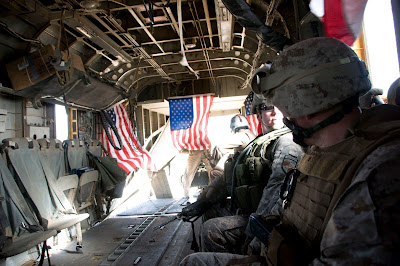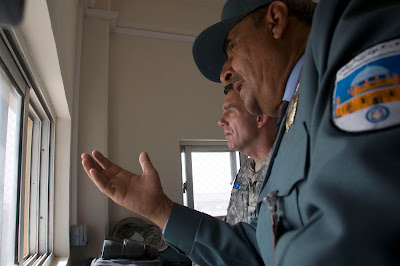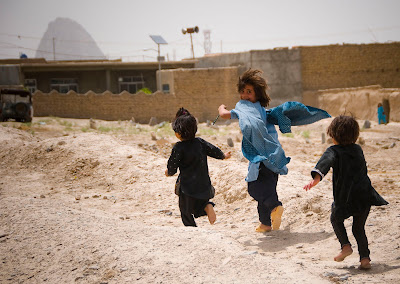 The heat was intense and stunning; as we stepped of the helicopter, the rotors pushed waves of suffocating hot air toward us. Sweating under 40 pounds of body armor, I stumbled over the rocky ground escaping the noise, dust and heat and climbed into the dirty and hot vehicle waiting for us. Baking under the southern Afghanistan sun, Helmand province is flat, dry and dusty. It is also home to Marjah, a district recently in the news as the site of major military operations conducted by U.S. and Afghan forces in order to clear out Taliban insurgents.
The heat was intense and stunning; as we stepped of the helicopter, the rotors pushed waves of suffocating hot air toward us. Sweating under 40 pounds of body armor, I stumbled over the rocky ground escaping the noise, dust and heat and climbed into the dirty and hot vehicle waiting for us. Baking under the southern Afghanistan sun, Helmand province is flat, dry and dusty. It is also home to Marjah, a district recently in the news as the site of major military operations conducted by U.S. and Afghan forces in order to clear out Taliban insurgents.On a recent visit to Marjah, my boss, Lt. Gen. William Caldwell IV, NATO Training Mission – Afghanistan commander, met with Afghan National Civil Order Police leadership to discuss challenges in the area.
 The training and development goals of NTM-A are multi-faceted, and although great strides have been made, there remain many hurdles to overcome. From recruiting to literacy development, building the Afghan National Security Forces is a complex challenge and nowhere are these challenges more apparent than in the Taliban strongholds of Kandahar and Helmand provinces.
The training and development goals of NTM-A are multi-faceted, and although great strides have been made, there remain many hurdles to overcome. From recruiting to literacy development, building the Afghan National Security Forces is a complex challenge and nowhere are these challenges more apparent than in the Taliban strongholds of Kandahar and Helmand provinces. Working side-by-side with U.S. Marine police mentor teams, the ANCOP, an elite police force, are continuing to provide a majority of the security in the area despite large scale operations ending two months ago. The goal is to recruit and train enough Afghan Uniform Police so that the ANCOP units can be utilized elsewhere, or return home for a rest.
Working side-by-side with U.S. Marine police mentor teams, the ANCOP, an elite police force, are continuing to provide a majority of the security in the area despite large scale operations ending two months ago. The goal is to recruit and train enough Afghan Uniform Police so that the ANCOP units can be utilized elsewhere, or return home for a rest.The problem, Regional Command – Southwest leaders told us, is with recruiting enough local police officers to take over permanently. Afghan Police, unlike their Army counterparts, are recruited locally, and once they complete basic training, serve in their home districts. Kandahar is the birthplace of the Taliban; with a strong insurgent presence lingering in there and in Helmand province, police recruitment is a difficult process at best.
 During a meeting with Afghan Maj. Gen. Sharif, ANCOP commander, the RC-SW commander, U.S. Marine Maj. Gen. Mills, told us his training center at Camp Leatherneck is ready to take on more ANP recruits. The Afghan manning document, or Tashkil, authorizes 311 police officers for Marjah, but there are only 90 currently serving; a class of 32 police officers started their eight-week basic training course June 21, however only eight of the new recruits were from Marjah.
During a meeting with Afghan Maj. Gen. Sharif, ANCOP commander, the RC-SW commander, U.S. Marine Maj. Gen. Mills, told us his training center at Camp Leatherneck is ready to take on more ANP recruits. The Afghan manning document, or Tashkil, authorizes 311 police officers for Marjah, but there are only 90 currently serving; a class of 32 police officers started their eight-week basic training course June 21, however only eight of the new recruits were from Marjah.“We keep hearing that there are young men out there who are interested in joining, and are on the fence. Many are concerned about their families and what would happen if they joined,” said Marine Lt. Col. Carlos Orellana, RC-SW C-10 director.
 Our visit took us to Combat Outpost Turbett, a small U.S. Marine post in Marjah where the Marine PMT’s live and work with ANCOP forces. From there, we walked through the village directly outside the post. Everywhere we went, we drew attention, and some friendly stares; a few villagers came up to shake hands with the Afghan and U.S. military leaders. On a stop in an unfinished building where Afghan police were taking shelter from the sun, little kids came up to us, curious as always. One little boy pointed at me and asked, “Is that a woman?” Sigh. I’m not sure if it was the armor I was wearing or just the fact that a woman walking around on the street with a group of men is a very rare sight. In fact, during our entire time down there, I didn’t see any women or even the little girls that I typically see out playing on the street.
Our visit took us to Combat Outpost Turbett, a small U.S. Marine post in Marjah where the Marine PMT’s live and work with ANCOP forces. From there, we walked through the village directly outside the post. Everywhere we went, we drew attention, and some friendly stares; a few villagers came up to shake hands with the Afghan and U.S. military leaders. On a stop in an unfinished building where Afghan police were taking shelter from the sun, little kids came up to us, curious as always. One little boy pointed at me and asked, “Is that a woman?” Sigh. I’m not sure if it was the armor I was wearing or just the fact that a woman walking around on the street with a group of men is a very rare sight. In fact, during our entire time down there, I didn’t see any women or even the little girls that I typically see out playing on the street. 
While we were talking to the boys, me kicking myself for not bringing candy, the sudden burst of gunfire broke through our conversation. Everyone stopped, and in the silence one of the boys said what we were all thinking, “Taliban” with a scared look on his face. Turns out there was a gun fight taking place in the street near-by, so after the marines and Afghan police cleared our new route, we headed back to the combat outpost. Gunfire broke out again during our stop at the new government district headquarters; this time we were getting into our MRAP’s when the gunner in my vehicle shouted down “Contact to the south, we’re getting contact to the south.”
 I twisted in my seat to see Afghan police running to get into defensive positions and ducking as bullets hit the walls around them, sending up plumes of dust. Ordered to stay in the vehicle, I could only watch and try to get a few pictures through the dusty window; the gunner was told not to engage unless our vehicle took a direct hit. In those few minutes, I could fully understand the frustration many Marine and Army ground forces say they feel with the restrictions on enemy engagement.
I twisted in my seat to see Afghan police running to get into defensive positions and ducking as bullets hit the walls around them, sending up plumes of dust. Ordered to stay in the vehicle, I could only watch and try to get a few pictures through the dusty window; the gunner was told not to engage unless our vehicle took a direct hit. In those few minutes, I could fully understand the frustration many Marine and Army ground forces say they feel with the restrictions on enemy engagement. Our visit only highlighted the challenges facing us as the U.S. and Coalition forces work with the Afghan government to create a safe and stable presence in the area. Unfortunately, it’s going to take a lot more time and effort from the Afghan government, military and civilian population, to completely remove the grip the Taliban has on the area. The civilians may be tired of fighting, but their fear of Taliban retaliation and their lack of education keep them repressed.
When it comes to securing their provinces, Afghan leaders, both civilian and police, recognize the challenges facing them and they seemed, more than anyone, to want to bring peace and stability to their people.






